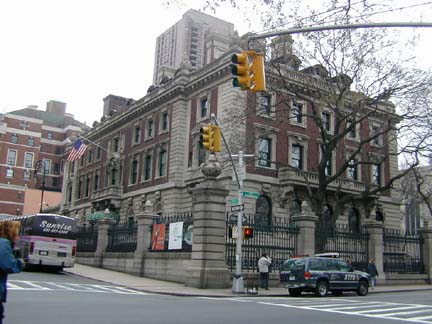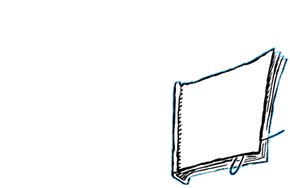Paper Engineering: Fold, Pull, Pop & Turn
The Smithsonian Exhibit June 14-2010 -Fall 2011
at The National Museum of American History, Washington, DC
By Ellen G. K. Rubin
(Reprinted from Movable Stationary August 2010; vol. 18, no.3)
The Heat of Passion. The Heat of Love. The Just Plain Heat. Passion and Love brought the plans to fruition, but it was the infamous Washington, DC heat we braved on Monday, June 14, 2010 to attend the much-anticipated opening of the Smithsonian exhibit, Paper Engineering: Fold, Pull, Pop & Turn. All decked out, my husband, Harold, and I took a taxi to the National Museum of American History. I was not walking from my hotel and into the exhibit wilted, dripping wet, and schvitzing. I wanted my excitement to be conserved and cool, in other words, uncharacteristically for me, contained.
Planning to keep a record of this much-awaited event, I posed for photos outside the Museum in front of the fountains and with the Washington Monument in the background. I wanted to remember this story especially in the context of our beautiful nation’s capital. The exhibit planning actually began years ago—maybe as many as four—when I ran into Eric Holzenberg, Director of the Grolier Club, and Stephen Van Dyk, Library Director of the Smithsonian’s Cooper-Hewitt National Design Museum in New York.

It was March at a hotel in Connecticut where the annual Ephemera Society show was being held. Harold and I were roaring in with my usual eagerness and hopefulness that I would secure movable bits of ephemera, postcards, trade cards, promotional material, etc. They were leaving. Eric introduced me to Stephen saying, “Stephen is thinking about an exhibit on pop-ups. Perhaps you’ll be able to help him?” Of course, I responded with an enthusiastic equivalent of “At your service!”
About 2 years went by until I heard from Stephen asking to take me up on my offer. He invited me to the Cooper-Hewitt to survey the books he was thinking about including in the exhibit. I was ushered through the side-door, probably the trade entrance in Andrew Carnegie’s day. (The mansion was Carnegie’s “vacation” home on land purchased in 1898 north of the city’s business district in lower Manhattan.)
We first talked about Stephen’s vision for the exhibit, about 50 books representing the various mechanisms used in movable books. He wanted to secure the earliest book possible. While I was familiar with most of what he showed me, I was delighted to handle some very old ones from the Cooper-Hewitt collection, especially, Euclid’s The Elements of Geometrie, 1570. Stephen was careful to point out that many books were part of the collection through the generosity of various donors. Over the next 2 years, with input from knowledgeable people like Ann Montanaro and Carol Barton, Stephen and I came up with a list. I begged and pleaded for the Astronomicum Caesareum to be included. When the Library of Congress would not part with theirs, Robert Gordon, a NY collector of astronomy books, offered his. It was thrilling and educational to collaborate with Stephen going back and forth over the history, timeline, glossary, and mechanisms of these books we loved. Adding to the excitement was talking to Sue Frampton, Program Coordinator of the Smithsonian Institution Libraries. Many of you may remember her from our conference in Washington, DC in 2008. Sue was making it her business to provide an exciting program of workshops and lectures to coordinate with the exhibit. These plans are still in the works.
My invitation arrived in a quiet white envelope but the invite itself was riotous with color emblazoned with an image from David Carter’s One Red Dot, 2005 that was to be the exhibit’s logo.

It now was all official and confirmed. Reality!!! A pop-up exhibit at the Smithsonian Institution!
I marched into the large American History rotunda head high with spirits to match. We had never been inside this museum. Visitors were still filing out. I flashed our invitation to the guard, passed through the metal detectors, and opened my bag for inspection. We immediately were confronted by a long table filled with colorful papers and behind the table, a line of smiling greeters. This was an ephemeral moment with a table filled with soon-to-be collectible ephemera: nametags with the exhibit logo, exhibit brochures, pop-up templates, and such. I grinned back at the greeters who were not wearing nametags, then set about looking for mine. Harold requested one for himself. Mr. Pop-up wanted to be recognized! At the edge of the table were colorful pop-up nametags, one with my name written on it. Nikki Krakora was so inspired by the exhibit, she created a few pop-up tags. I only took my nametags and left the rest of the material for after the reception so that my hands were free for shaking and hugging….and hors d’oeuvres which, as it turned out, I was too excited to eat anyway. The cavernous entry hall was lined with glass cases. I could have sworn I saw C3PO wave “Hello” as I went by.
We hardly needed directions to the first floor gallery Dibner Library since the din of conversation reeled us in. “A nice turn-out,” I thought, ‘though I didn’t know what that meant in this context. Immediately Robin Sutton, the archivist, approached, wine in hand. In a recent email she mentioned she’d be visiting her parents in Virginia the week of the opening. She was graciously included on the invite-list. I was tickled that she could see books she had worked on, especially The Children’s Haggadah (1933) I had loaned to the exhibition. In turn, she had brought Larry Seidman and JoAnn Reisler. The Movable Book Society was well represented.
My eyes scanned the room for Stephen. This was his moment, and I was eager to congratulate him. And there he was surrounded by what I could only expect was an adoring crowd. I excused myself and made my way to him. We exchanged big, warm hugs. But…I was yet to see the exhibit!
Leaving our drinks at the door as was “suggested,” Robin and I passed under the sign for the Dibner Library and the exhibit’s announcement—Fold, Pull, Pop & Turn in bright red and yellow. Just like these dynamic books, the exhibit opens with a whirl and a pop. At the door in the first case, two books are attached to electronic arms. Push a button and Reinhart’s The Pop-up Book of Phobias thrusts the dentist’s drill right in your face. Push a second button and Bruce Foster’s WOW! The Pop-up Book of Sports has you experience David Tyree’s “miracle catch” in Super Bowl XLII then opens to the super-surfer, Kelly Slater, riding the waves. Look to your left and the c1940 Ali Baba and the 40 Thieves by Mario Zambini rotates before your eyes on a turntable allowing you to see every deep, detailed spread.
I’ll not be going over the books in every case but giving you some highlights. Alas, there is no proper catalog of the exhibition. Perhaps you are so inclined to make a donation either personal or corporate to change that. There is the colorful brochure that has several of the books beautifully photographed and is touchingly dedicated to Wally Hunt. Two videos enhance the exhibit. The first video shows the opening and closing of a representative pop-up from several books in the exhibition . The second, at the very back wall of the exhibit, is the crowd pleaser. Produced by Sean McGee and financed by the Buster Foundation, this 8-minute-plus video features Bruce Foster and Chuck Fischer showing step-by-step how they made the Gabriel spread from their book, Angels. If the exhibit were not already free, I would tell you that seeing this video alone is worth the price of admission. As we stood amid the crowd gathered around the screen, I could hear people comment, “I never knew how hard it is to make these books.” or “So that’s why pop-ups are more expensive.” Viewers were mesmerized. I shouldn’t tell you this so that you’d make it your business to get to the exhibit, but the video is available on YouTube and on this website.
Another highlight for me was the case showing volvelles. Sitting shoulder-to-shoulder with the book I consider the most beautiful movable book ever made, Apianus’ Astronomicum Caesareum was The Children’s Haggadah. I couldn’t have been prouder. The Astronomicum drew the most WOWS! in the exhibit, both for its beauty and its age. I was lucky to meet Robert Gordon who had loaned the Apianus to the exhibit. He had been alerted to the deaccessioning of both the Apianus and the Thurneysser zum Thurn,Leonhardt (1531-1596) one of the most complicated books I’ve ever seen. He was encouraged to make a bid and he did—a winning one! What a lucky guy! Lucky me to be invited to visit these two glorious books in Robert’s home in NYC.To get from one end of the exhibit to the other, visitors have to walk around center kiosks that display a glossary of pop-up terms, a timeline, and images of the various mechanisms. Moerbeek’s RolyPoly floated behind exhibit glass looking like Santa’s sleigh and reindeer soaring on Christmas Eve. When Harold and I returned to the museum the next day to savor the exhibit in slo-mo, we heard visitors marveling at the age of the books and the subjects they covered. Unfortunately, some never saw the buttons to open and close the pop-ups, and I wish there was a large arrow pointing to them. Another suggestion would be to change “Paper Engineering” to “Pop-up Books” on the museum’s directories throughout the building. The former phrase is not as familiar to the general public as is the latter and this change may have more people seeking out the exhibit. Cutting the viewing short, I returned to the Opening Night festivities to hang out with the other attendees. We had an extended photo-op session with Chuck, Stephen, and Sue. I sorely felt the absence of Ann and Bruce. It was fun meeting employees of the Smithsonian who either already collected pop-ups or were inspired to by working on the exhibit. There were generous donors to the Smithsonian and fellow members of the Grolier Club present. JoAnn Reisler extended an unprecedented invitation for me to come visit her private collection of movable books rumored to have Meggendorfers with dust jackets. You’ll be hearing from me JoAnn! The official opening was presided over by Nancy Gwinn, Director of the Smithsonian Libraries. She thanked everyone including the custodians! She also announced it was Stephen’s birthday and there was a great cake for all of us to share. Stephen who was way too humble to speak of his enormous part in the exhibit followed Nancy, but then, he was the curator and that title says it all. Reluctantly we bid our goodbyes and repeated our congratulations. With an exhibit as exciting as this one, they were all well deserved. Now I had to cool down!
Click here for images from the reception.

